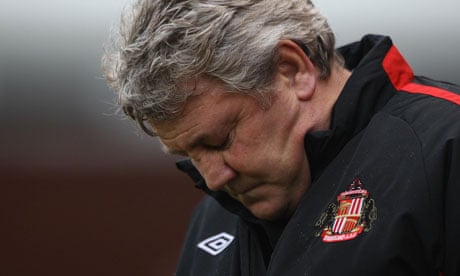Shortly after taking charge at Sunderland Steve Bruce was asked if he had considered experimenting with a Christmas Tree formation. "I'm not really into tactics," he replied. At the time that response was easy to interpret as a deliberately flippant or, perhaps, a self-deprecating means of avoiding answering the question. As the seasons passed, though, the suspicion grew that the former Manchester United captain had simply been honest.
Arguably one of the principal reasons Bruce is no longer in charge at the Stadium of Light concerns his apparent inability to tweak formations or tactics during matches. Whenever a rival manager re-configured his system mid-game, Bruce invariably failed to come up with a countermeasure.
In recent months Alan Pardew, Mark Hughes, Roy Hodgson and, most recently, Roberto Martínez have all seemingly out-thought him as Sunderland dropped points against supposedly weaker sidesthey really should have beaten.
If he failed to cut it as a tactician, the 50-year-old did not seem much of a strategist either. Including loans, 30 players were signed – several of whom have subsequently been moved on – during Bruce's two-and-a-half years on Wearside. That represents an unsettling "churn" factor and hardly proved conducive to developing either a clear playing philosophy or strong team spirit.
Always rather amorphous, if not downright scrappy, Sunderland's high-tempo style lacked creativity, not to mention control, in central midfield. Unable to dictate play, the team frequently failed to press home early advantages.
In many ways Bruce's decision to make the hot-headed, yellow card-prone Lee Cattermole his captain proved emblematic of a rather gung-ho reign during which players such as David Meyler were rushed back from serious injuries only to suffer further complications, the idea of hiring a sports psychologist was dismissed and the manager boasted about his inability to send an email. While Bruce – who did finally learn how to log on last summer when the club issued him with an iPad – may well argue this lack of computer literacy was hardly relevant, many of his peers spend countless hours checking out the latest sports science innovations, researching transfer targets and analysing Prozone statistics on their increasingly indispensable laptops.
Unashamedly old school, Bruce believed that motivation was the key to management but the influx of overseas coaches has raised the Premier League's technical bar and despite his relative youth, he has begun to look suspiciously like a man whose era has passed.
Unlike many modern managers he did not coach the team himself, delegating that job to his assistant, Eric Black. While Bruce's undoubtedly engaging, humour-suffused, personality had a broad appeal, he fell out with quite a few players, most notably Kenwyne Jones, now at Stoke, and Anton Ferdinand, now at QPR and who had by common consensus finally emerged as Sunderland's outstanding defender when he was sold in August.
Shortly afterwards Sunderland's manager was badly let down by Titus Bramble, who faces a crown court trial on sexual assault charges in January. Other bad buys included Matthew Kilgallon, Christian Riveros, Marcos Angeleri and Paulo Da Silva. Meanwhile Craig Gardner, bought from Birmingham for £6m, has barely figured in the first team.
There were some good purchases along the way, too, such as Lorik Cana, Asamoah Gyan and, above all, Darren Bent . Unfortunately Bent had become desperate to leave Sunderland six months before his eventual move to Aston Villa in January. Cana headed to Turkey after just a year while Gyan has newly gone to United Arab Emirates on loan. Money evidently played a big part in all these deals, but it does not represent the entire behind-the-scenes story.
Something was clearly wrong because, as last season's promising beginning subsided into a post-new year collapse, managerial excuses increasingly became a recurring, if self-destructive, theme.
It certainly did not play well with Sunderland fans when the crowd were blamed for harbouring overly "great expectations" or that Bruce constantly bemoaned the difficulty of attracting players to the north-east. More recently, his loudest lament has been that locals would not accept him purely because he had been born north of the Tyne and grew up supporting Newcastle United.
Granted, a minority shamefully hurled chants of "You fat Geordie bastard – get out of our club" after Saturday's defeat to Wigan, but the overwhelming majority of supporters did not care about his roots. Moreover their "expectations" were mostly pretty modest.
Two home wins since New Year's Day have tried Wearsiders' patience but, contrary to Bruce's theories, many would have taken the odd defeat to Newcastle in their stride had there been signs of progress or a discernible playing pattern emerging. Maybe the core problem was that Bruce never accepted that, sometimes, the devil really is in the detail. Soon after Ahmed Elmohamady arrived from Egypt, Sunderland's manager was asked if the winger would be observing Ramadan and if so, how the daylight fasting might affect his game.
The question was met with a blank look. "Is Elmohamady a Coptic Christian rather than a Muslim then?" the questioner persisted. It was an important distinction and the answer should have tripped off Bruce's tongue, but he clearly did not have a clue.

